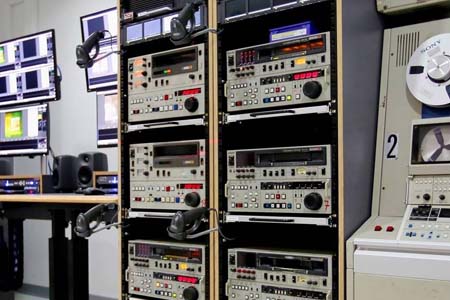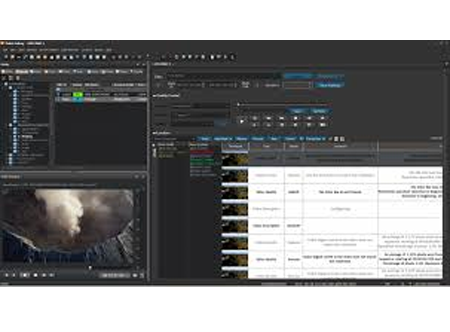It is only by reimagining archive as a unified repository of assets, which are integral to production, preparation and delivery workflows, that its value can be unlocked, says Raoul Cospen Content owners have traditionally archived material as a resource worth keeping in perpetuity, but this simplistic approach is no longer fit for purpose. While vintage […]
 It is only by reimagining archive as a unified repository of assets, which are integral to production, preparation and delivery workflows, that its value can be unlocked, says Raoul Cospen
It is only by reimagining archive as a unified repository of assets, which are integral to production, preparation and delivery workflows, that its value can be unlocked, says Raoul Cospen
Content owners have traditionally archived material as a resource worth keeping in perpetuity, but this simplistic approach is no longer fit for purpose.
While vintage programming can be transferred into the production server to flesh out a TV schedule, the spread of online distribution platforms has dramatically increased the demand for more diverse content, which broadcasters are under pressure to meet. What’s more, the intelligent use of archived material from audio and video media to ancillary information such as subtitle tracks can be worked into a significant revenue stream.
Archived material can go a long way to strengthen and refresh a broadcaster’s inventory to fuel on-demand access, international sales or to enhance new productions. Invariably though, often detailed knowledge about the content is unavailable or it is in a state where it cannot be easily unlocked.
If assets are stored on disparate hard discs, siloed servers or on shelves as tape, there will be considerable wasted time, effort and cost in locating, retrieving and collaborating on content creation and onward distribution. Time to air is impacted and the archive is effectively devalued.
An archive system used solely for preservation or for legal compliance realises very little of its true value and barely justifies the ongoing cost of acquisition, documentation and maintenance.
Only by reimagining the archive as a unified repository of assets, which are integral to production, content preparation and content delivery workflows, can its value be transformed.
How can you do that?
The starting point has to be the particular needs of the organisation. What do you want the archive to achieve in terms of production and distribution? Is there a need to keep content available for production or to organise it for on-demand and catch-up services? Which assets should be considered live after transmission to optimise storage?
Armed with this strategic vision, organisations can begin implementation by structuring and generating metadata models. Metadata is the building block of asset management and essential not only for making content searchable, but for automating the crucial links between assets.
While many facilities will have installed an asset management system for a portion of their workflow, these systems are unlikely to have the scale, power or intelligence to search for or relate files to one other in any efficient, integrated or meaningful way.
This is because metadata is vastly more complex today than in the early days of tapeless workflows, when a single metadata set equated to one media file. With the expansion of file-based media, multiple files were required to create different formats (e.g., distribution versions) or resolutions (e.g., proxy, high resolution) of the same content. To that mix was added subtitles, language tracks and captions for various outputs.
The situation continues to increase in complexity, to the extent that an individual file will make little sense in isolation. The German language subtitle file for a premium English language movie, for example, holds little value without relevance to its constituent parts. It is the relationship between files that is important, and an asset management system must be powerful enough to make sense of the connections.
Metadata modeling
Metadata sets will, of course, differ depending on the type of content. News, for example, doesnt have the same metadata set as a drama or a sports game. And even, soccer and tennis would have very different metadata sets.
Digging deeper, under the broad asset description of a particular soccer match, you will find files for different resolutions of that game plus related logs and metadata. Deeper subsets still might contain match highlights or feeds from various camera angles, pre-game and post-game interviews, press conferences, Twitter feeds and other user-generated input, or of the five-minute preview produced for mobile handsets. All of these files and associated metadata are bracketed by the same asset.
Similarly, a drama will be copied as a master file with different audio and subtitle tracks in different languages. There may be different length versions, re-edits for compliance, a AS-11 file for delivery to UK broadcasters, a Dolby audio file for theatrical release and so on. Related promos, shot lists, time-coded transmission information, scripts, production notes and cast lists all fall under the same asset.
A facility’s asset management system should be able to combine these different, complex asset models as well as the links between them in a way, which is easily configurable to fit the user’s needs and which evolve over time as new distribution needs arise.
Smart MAM
There are further attributes of a successful integrated asset management platform. For manual input, users should be driven by the system so that they enter the right metadata at the right time, depending on the context and the type of content. Items like controlled vocabulary, thesaurus and glossaries really help in this context.
While advancing in quality, speech-to-text technologies cannot be relied upon for 100% accuracy, although they can provide a good basis for automated input.
When used in conjunction with other types of logging, such as scene detection, facial recognition and semantic interpretation, it is possible to enrich content automatically with relevant metadata and to clean up raw metadata.
Production and technical metadata can be augmented by automatically linking data feeds relevant to the business. The MAM should be able to seamlessly import external data feeds, as needed for the operations. There are many examples around XML exchange standards like SportsML, alongside feeds from Opta (which provides teams, rosters, logs and statistics), that bring in valuable data in the context of sports material. Similarly, NewsML dope sheets provide extra valuable information about topics, location, context and broadcast rights.
It is important that the archiving system is capable of tracking and propagating the metadata that you have invested in creating and gathering. With genealogy and metadata inheritance, it is possible to trace and correctly action broadcast rights and descriptive metadata. Ideally, as you edit a new asset, the user won’t need to re-enter all the metadata again and again, reducing labour and risk of error.
Search and browsing technologies such as federated search or navigation of links between assets will help to quickly locate relevant content and enrich production with more archived content.
Integration capabilities
To maximise the value of your archive, it needs to be integral with production, content preparation and distribution workflows. This means a MAM that is interoperable with third-party hardware and software, compliant with industry standards, and has the ability to easily import metadata from legacy systems.
Once integrated by the MAM system, the archive’s rich metadata can be analysed to optimise storage. Content can be held on production systems for instant access, on spinning disc for near-line access, or on tape libraries or servers for deeper archive, possibly accessible over the cloud. Bespoke business rules based on how fast access needs to be, the cost of storage and the organisation’s goals can assign content to the appropriate archive tier and, therefore, optimise the archive infrastructure.
Regardless of media, whether for news, sports, radio, long form programmes or every piece of content that passes through a facility, it is imperative to think beyond storing files on tape libraries and disks and to think in terms of freeing that content up to work better for you with addition of rich, consistently applied metadata.
For this, a flexible asset management solution is required, one that is built around the archive to unlock all of its potential. This will be a MAM solution that has the intelligence to recognise links between metadata files, the power to search, browse and exchange assets, and that has the scale to expand as production and business planning demands. All of that requires a top down vision that removes archive from the sidelines and places it at the heart of future business.
Raoul Cospen is Director of Marketing and Business Development at Dalet.










































































